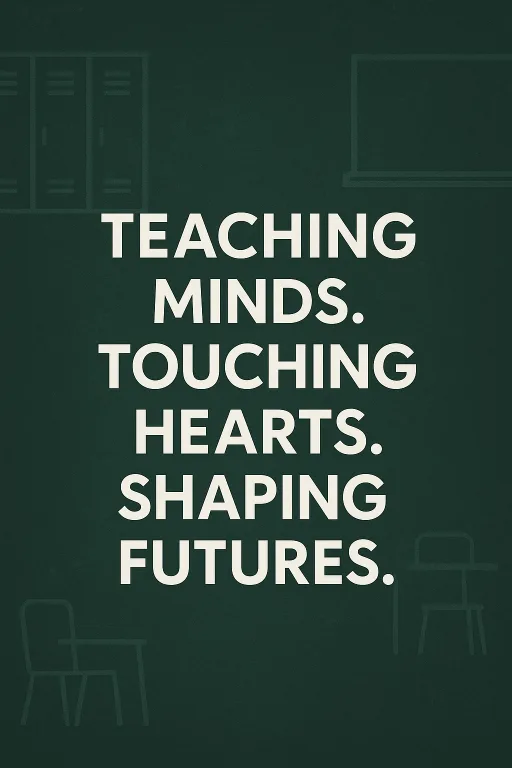Teaching Minds, Touching Hearts, Shaping Futures: The Power of Purposeful Education
Introduction to Purposeful Education
Purposeful education—”Teaching Minds. Touching Hearts. Shaping Futures.”—is more than a slogan. It’s a transformational philosophy reflected in the powerful image above, where these guiding principles are displayed boldly against a chalkboard backdrop 🧠❤️🌱. Each phrase calls attention to a core component of meaningful teaching: intellectual development, emotional connection, and lifelong impact.
In this blog, we’ll explore how modern educators can embody these ideals in classrooms and beyond. We’ll dive into cognitive strategies for engaging student minds, emotional intelligence techniques to reach their hearts, and visionary curriculum planning to shape their futures. Drawing insights from educational technologies found on the Products Page, inspirational experiences on the Blogs Page, and innovation trends on the Tech Insights Page, this guide will illuminate how educators can become transformational figures in their students’ lives. To support this narrative, we’ll reference authoritative sources like Edutopia to highlight proven, real-world practices.
Table of Contents
- Teaching Minds: Cognitive Engagement in the Classroom
- Touching Hearts: Emotional Intelligence in Education 💖
- Shaping Futures: Preparing Students for Life
- Tools and Techniques for Transformational Teaching
- Purpose-Driven Education in the Digital Age
- Frequently Asked Questions (FAQs)
- Conclusion: Final Thoughts on Purposeful Education
Teaching Minds: Cognitive Engagement in the Classroom
The first pillar of purposeful education is intellectual empowerment. “Teaching minds” means nurturing curiosity, encouraging critical thinking, and making learning meaningful 🧠. In classrooms, cognitive engagement goes beyond textbooks—it involves inquiry-based learning, Socratic dialogue, project-based tasks, and real-world applications.
Educators should ask: Are my students thinking deeply? Are they solving problems creatively? According to Edutopia, engaged learners show persistence, confidence, and intellectual risk-taking.
Key strategies to engage student minds:- Flipped Classrooms: Learners absorb content at home, discuss and apply in class.
- Metacognition Exercises: Help students reflect on how they learn, not just what they learn.
- Choice Boards: Offer different ways for students to explore concepts based on interest.
- Gamification: Use educational games to make abstract topics more engaging and accessible.
Explore tools and teaching aids on the Products Page that make this type of learning scalable and impactful.
Touching Hearts: Emotional Intelligence in Education 💖
While teaching minds builds knowledge, touching hearts creates connection and trust. A student who feels seen, heard, and valued learns more deeply and consistently. In the image above, “Touching Hearts” sits at the center of the statement—reflecting its centrality in transformative education.
Emotional intelligence (EQ) in education includes:- Empathy-Driven Teaching: Understanding a student’s challenges before addressing performance.
- Trauma-Informed Practices: Responding to adverse childhood experiences with compassion and structure.
- Restorative Conversations: Moving beyond punishment to relationship-building in classroom management.
- Celebration & Feedback: Acknowledging student effort with specificity and sincerity 🎉.
As technology evolves, so does emotional teaching. Tools highlighted on the Blogs Page offer examples of how educators use virtual journaling apps and AI-driven wellness dashboards to monitor and nurture student well-being.
Shaping Futures: Preparing Students for Life
The phrase “Shaping Futures” represents the long game of education—equipping students with the skills, character, and confidence to thrive in life, not just exams. Great educators help students discover passions, build resilience, and contribute meaningfully to the world 🌍.
Future-ready education includes:- Career Exploration: Introduce students to multiple pathways—vocational, academic, entrepreneurial.
- Digital Citizenship: Teach responsible tech use, online safety, and digital footprints.
- Financial Literacy: Budgeting, saving, investing—essential skills often overlooked in traditional curricula.
- Global Competence: Understanding diverse cultures, viewpoints, and global issues.
At the Tech Insights Page, you’ll find AI-powered education platforms that offer personalized career guidance, adaptive learning paths, and portfolio-building tools for today’s students.
Tools and Techniques for Transformational Teaching
To teach minds, touch hearts, and shape futures, educators need the right tools and pedagogical practices. Here are some proven, tech-enhanced teaching strategies:
- Interactive Whiteboards: Facilitate real-time collaboration and visual learning.
- Digital Portfolios: Showcase student growth over time, blending academic and creative work.
- Formative Assessment Tools: Platforms like EdPuzzle, Quizizz, and Socrative track learning progress instantly.
- Learning Management Systems (LMS): Tools like Google Classroom or Canvas simplify content delivery, feedback, and communication.
All of these support educators in balancing intellect, emotion, and foresight. For classroom-tested recommendations, check out our Products Page and Blogs Page.
Purpose-Driven Education in the Digital Age
Digital transformation in education is not about replacing teachers—it’s about empowering them. From AI tutors to virtual reality classrooms, purposeful educators now have unprecedented access to global content and data-driven insights 🔍.
But at the heart of every tool is still the teacher—the one who teaches minds, touches hearts, and shapes futures. Combining technology with humanity is the secret to sustainable educational success.
Digital-age best practices:- Blended Learning: Seamlessly integrate online and offline experiences.
- AI Tutoring Assistants: Provide 24/7 support without replacing classroom engagement.
- Data-Informed Teaching: Use analytics to personalize support and interventions.
- Student Voice Platforms: Enable learners to share ideas, reflections, and goals publicly.
Explore how educators are applying AI and analytics at the Tech Insights Page.
Frequently Asked Questions (FAQs)
- What does “Teaching Minds, Touching Hearts, Shaping Futures” mean?
It describes a holistic approach to education where educators nurture intellect, emotional well-being, and life-readiness. - How can teachers touch students’ hearts effectively?
By building trust, practicing empathy, giving sincere feedback, and responding to emotional needs proactively. - What’s the best way to prepare students for the future?
Provide real-world skills, mentor their interests, and guide them with tools and opportunities that reflect modern life.
Conclusion: Final Thoughts on Purposeful Education
The image with “Teaching Minds. Touching Hearts. Shaping Futures.” is not just art—it’s a mission statement. Each phrase is a call to action for educators who believe in the transformative power of teaching 💫.
In this age of AI and automation, the most impactful teachers will be those who merge intellectual rigor with emotional depth and visionary planning. Start by upgrading your toolbox via the Products Page, gain inspiration from other educators on the Blogs Page, and explore the future of tech-infused education on the Tech Insights Page.
🎬 Want to share this mission visually? Try prompting Sora with: “Create a heartfelt short film about a teacher who helps a struggling student discover their true potential—both in school and in life.”


